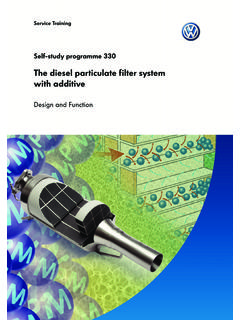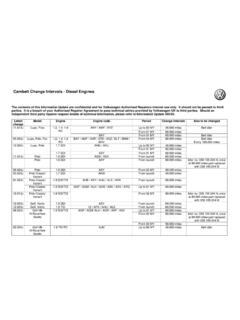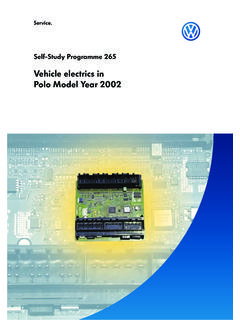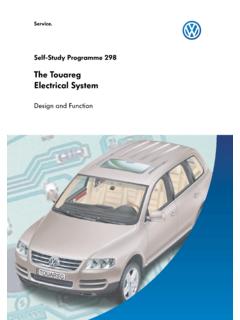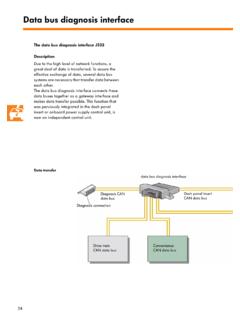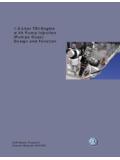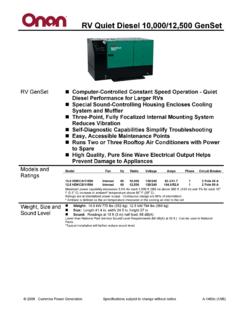Transcription of Service - VolksPage.Net
1 The and TDI enginesWith Pump injection SystemDesign and FunctionSelf-Study Programme 223 Service 2 New ImportantNoteThe Self-Study Programme describes the design and the function of new developments! The contents are not updated!Please always refer to the relevant Service Literaturefor all inspection, adjustment and repair the successful launch of 4-cylinder TDI engines with unit injector system in the Golf and Passat, the trend towards economical, low-emission and simultaneously powerful direct- injection turbodiesel engines is continued in the Polo and Lupo by the 3-cylinder TDI eliminating a single cylinder, the engines are now lighter, have fewer moving masses and produce less friction than a 4-cylinder engine. Despite their lower displacement, they have a high performance potential for this vehicle in the TDI engine developed specially for the Lupo 3L, numerous new technologies and production methods have been employed in order to achieve the development goal of reducing fuel consumption to 3 litres per 100 km.
2 This consumption figure was made possible by saving weight, reducing friction and improving the combustion this Self-Study Programme, you have the opportunity to familiarise yourself with this new engine generation, which is exemplified by the and TDI ..4 Engine mechanicals ..8 Unit injector system ..27 Fuel supply ..38 Exhaust system ..43 Engine management ..46 Function diagram ..70 Starter motor..72 Engine management (special features of the Lupo 3L)..76 Service ..79 Test your knowledge..854 IntroductionYou will find detailed information regarding Lupo 3L and Audi A2 in the following Self-Study Programmes: No. 216 Lupo 3L Body No. 218 Lupo 3L TDI No. 221 The DS 085 Electronic Manual Gearbox No. 239 Audi A2 - Body No. 240 Audi A2 - Engineering No. 247 Audi A2 - Engine and Gearbox +=+=223_214223_138223_215223_216223_1372 23_217223_219 The TDI engineis combined with the DS 085 electronic manual gearbox and is fittedexclusively in the Lupo TDI engineis combined with 5-speed manual gearbox 02J and is fitted in the Lupo, Polo and Audi variants5 Designations and levels of development of the enginesBoth the engine and the TDI engine were developed on the basis of the TDI engine without intermediate shaft and with unit injector system.
3 They belong to the EA 188 engine series (EA=development order). As this designation often appears in specialist publications, we shall now briefly explain the various diesel engine series of four-cylinder diesel engines are subdivided into two series: the EA 086 series of swirl chamber engines and the EA 180 series of direct injection engine engines. A key feature of these engine series is the intermediate shaft which drives the oil pump and the vacuum pump. The EA 180 engines were revised with the introduction of the new A-platform class in 1996. This gave rise to the EA 188 engine new engine series does not have an intermediate shaft. The oil pump is driven by the crankshaft by means of a chain. The vacuum pump is mounted on the cylinder head and is driven by the camshaft. Further features of the new engine series are the upright oil filter housing, the coolant pump integrated in the cylinder block and the pendulum engine series are the 5-cylinder inline engine series EA 381 and the V6 TDI engine series EA 330 launched in shaftOil filterVacuum pumpUprightoil filter housingOil pumpVacuum pumpOil pumpCoolant pumpEngine series EA 180 Engine series EA 188 Coolant TDI TDI engineEngine codeANYAMFType3-cylinder inline engine3-cylinder inline engineDisplacement1191 cm 1422 cm Bore / mm / mm/ mmCompression : : 1 Firing order1 - 2 - 31 - 2 - 3 Engine managementBOSCH EDC 15 PBOSCH EDC 15 PFuelDiesel min.
4 49 CN or biodiesel (RME)Diesel min. 49 CN or biodiesel (RME)Exhaust gas aftertreatmentExhaust gas recirculation and oxidation catalytic converterExhaust gas recirculation and oxidation catalytic converterExhaust emission standardConforms to exhaust emission level D4 Conforms to exhaust emission level D3 SpecificationsIntroduction223_216223_214 7 The maximum power output of the TDI engine is 55 kW at 4000 TDI engine has two different performance achieve consumption figures of 3 litres per 100 km, the Lupo 3L has an Economy mode in which engine performance is reduced by the enginemanagement system. For a more sporty driving style, the engine can be operated in the performance-oriented Sport the reference performance curve shows, the maximum output of the TDI engine is 45 kW at 4000 rpm. In Economy mode, maximum power output is 33 kW at 3000 diagram Torque diagram Power output and torqueThe TDI engine develops 195 Nm of torque at 2200 rpm, hence the engine's high tractive power and elasticity in the lower and medium speed the TDI engine is in Sport mode, the maximum torque of 140 Nm is available between 1800 rpm and 2400 Economy mode, maximum torqueis 120 Nm between 1600 and 2400 rpm.
5 As a result, high torque is available in the speed range which is predominantly [kW][rpm] engine - Sport engine - ECO engine223_009[Nm] engine - Sport engine - ECO engine[rpm]8 The cylinder blockThe cylinder block of the TDI engine is manufactured from an aluminium alloy to save weight and minimise the fuel consumption of the Lupo gray cast iron cylinder liners of the engine are press-fitted and cannot be mechanicals223_057 The crankshaft bearing covers may not detached and the crankshaft may not be removed. Undoing the bearing cover bolts causes the aluminium bearing seats to lose shape due to relaxation of their inner the bearing cover bolts are undone, then the cylinder block has to be replaced complete with the TDI engineCylinder linersThe TDI engine has a gray cast iron cylinder TDI engine9 Steel pins serve as tension bolts: they bolt the aluminium cylinder block to the cylinder head and the crankshaft bearing cap of the TDI are securely glued into the cylinder block with Loctide locking fluid and cannot be installation of the cylinder head, tightening of the cylinder head nuts puts a high torsional strain on the tension bolts.
6 To reduce the strain, the cylinder head nuts have to be slackened. Please observe the instructions in the Workshop Manual!Cylinder head nutTension boltCrankshaft bearing cap223_059 The tension boltAluminium is not as strong as gray cast iron. If the cylinder head in the cylinder block has a conventional threaded connection, there is a danger of the threaded connection coming undone due to the high combustion pressures which develop inside diesel this reason, the cylinder head and the cylinder block are bolted together by tension bolts. The tension bolts permit a continuous flow of force from the cylinder head to the bearing cover, securely holding the engine together even under heavy load. This makes for a secure threaded connection and reduces the strain on the cylinder connectionThreaded connectionwith continuouslypositive engagement10 The balancing shaftA balancing shaft is located in the engine's crankshaft drive. Its task is to reduce vibration and thereby ensure that the engine runs balancing shaft is attached to a ladder-type frame and is driven by the crankshaft by means of a chain.
7 It rotates at engine speed in the opposite direction to the upwards and downwards movements of the piston and conrod and the turning motion of the crankshaft produce forces which induce vibrations. These vibrations are transmitted through the assembly mounting to the vehicle body. To reduce vibration, the balancing shaft counteracts the forces of the piston, conrod and mechanicals223_212 Ladder-type frameCounterweightHydraulicchain tensionerCrankshaftBalancing shaft11 What is force?The concept of "force" is derived from the tensing of muscles as experienced when lifting or pulling an object. When a force acts upon a solid object, it can cause the object to become deformed, accelerate or produce a counterforce of equal permutations are also an apple is thrown, it is accelerated by the effect of muscular power. The magnitude of the force required to throw the apple is dependent on the apple's mass (weight) and a drawing, the magnitude of a force, its direction of action and the point of application are represented by an :Force = mass x accelerationTo be able to better understand the operating principle of the balancing shaft, several basic physical terms are briefly explained on the following mechanicalsForce due to form of force is force due to to gravitational acceleration, each body moves towards the earth's surface and produces a force due to weight.
8 The force due to weight is dependent on the mass of a body and the gravitational acceleration, and is generally referred to as the force of attraction . The greater the mass of the object, the greater the force due to due to weight = mass x gravitational acceleration223_086 What is torque?If a force acting vertically on an object induces a rotational motion via a lever, this is referred to as 'torque'. Since neither the force nor the lever arm alone determine the direction of rotation, the product of both is referred to as torque. Torque increases as a function of increasing force or lever arm :Two weights are located on a balance. Weight A is twice as heavy as weight B. On account of its higher mass, it produces greater torque as than weight B and lifts weight B because of = force x lever arm223_195 ABExample:LL(L= length)Pivot13 Engine mechanicalsHow do torquescancel each other out?Moments cancel each other out when the force counteracts a force of equal magnitude at equal distances from the 1: Three weights are located on the balance.
9 Weight A is on the left-hand side and weightsB1 and B2 are on the right-hand side. As weights B1 + B2 are equally as heavy as weight A, the force and counterforce cancel each other out, a force equilibrium exists. or:Moments cancel each other out when a counterforce of half the magnitude counteracts the force at twice the distance from the 2: Two weights are located on the balance. Weight A is on the left-hand side and weightB is on the right-hand side. Weight B is located twice the distance away from the pivot. As a result, the torques on both pages are equalised and a force equilibrium 1:Example 2:223_197223_196A B1B2 LLAB2 x LL14 Engine mechanicalsRotating inertia forces are produced by the turning motion of the crankshaft (action of centrifugal force). rotation = orbital motion around own axisOscillating inertia forces are produced by the upwards and downwards movements of pistons and = back and forward swinging motionHow do inertia forces affect the 3-cylinder TDI engine?
10 When one observes the crankshaft of the 3-cylinder TDI engine from the side, the crank throws are uniformly arranged in relation to the crankshaft's pivot. The throws are spaced 120 apart. As a result, the inertia forces cancel each other 120 120 Inertia forcesInertia forces occur in the engine's crankshaft drive. There are two types of inertia force: rotating inertial forces and oscillating inertial moments of inertiaMass moments of iner tia occur in the crankshaft drive of the 3-cylinder TDI engine since the inertia forces act upon the centre point of the crankshaft via different lever arms. 4-cylinder engine3-cylinder engine223_176223_177 The crankshaft of the 4-cylinder inline engine appears symmetrical from the long side. The crankshaft throws have the same distance in relation to the centre point of the crankshaft. As a result, the mass moments of inertia cancel each other crankshaft of the 3-cylinder inline engine is not symmetrical, because the throws are different distances away from the centre point of the crankshaft.
